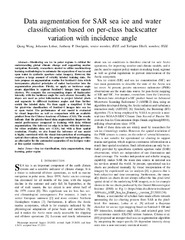| dc.contributor.author | WANG, QIANG | |
| dc.contributor.author | Lohse, Johannes | |
| dc.contributor.author | Doulgeris, Anthony Paul | |
| dc.contributor.author | Eltoft, Torbjørn | |
| dc.date.accessioned | 2024-02-23T11:54:43Z | |
| dc.date.available | 2024-02-23T11:54:43Z | |
| dc.date.issued | 2023-07-03 | |
| dc.description.abstract | Monitoring sea ice in polar regions is critical for understanding global climate change and supporting marine navigation. Recently, researchers started to utilize machine/deep learning methodologies to automate the separation of sea ice and open water in synthetic aperture radar imagery. However, this requires a large amount of reliably labeled training data. We here propose an augmentation routine for Sentinel-1 data, which incorporates physical principles of radar backscatter into the augmentation procedure. First, we apply an incidence angle (IA)-aware algorithm to segment Sentinel-1 images into separate clusters. We compute the corresponding slopes of backscatter intensity with the IA for each cluster. Second, the slopes are used as prior information to project labeled pixels and segments to different IAs and thus further enrich the labeled data. We then apply a simplified U-Net for pixelwise classification of Sentinel-1 images into sea ice or open water. The performance of our model is evaluated by visual inspection as well as comparison with an available product from the Chinese Academy of Sciences (CAS). The results indicate that the physics-based data augmentation improves the model performance compared to training with data without augmentation. The inferred ice edge is in line with the inference for other available datasets (CAS), but with a finer spatial resolution. Finally, we also found that the inference of our model is highly correlated with the visual interpretation of overlapping optical observations. Overall, the proposed methodology provides an alternative for the automated separation of sea ice/open water at fine spatial resolution. | en_US |
| dc.identifier.citation | WANG, Lohse, Doulgeris, Eltoft. Data Augmentation for SAR Sea Ice and Water Classification Based on Per-Class Backscatter Variation With Incidence Angle. IEEE Transactions on Geoscience and Remote Sensing. 2023;61 | en_US |
| dc.identifier.cristinID | FRIDAID 2170817 | |
| dc.identifier.doi | 10.1109/TGRS.2023.3291927 | |
| dc.identifier.issn | 0196-2892 | |
| dc.identifier.issn | 1558-0644 | |
| dc.identifier.uri | https://hdl.handle.net/10037/33029 | |
| dc.language.iso | eng | en_US |
| dc.publisher | IEEE | en_US |
| dc.relation.journal | IEEE Transactions on Geoscience and Remote Sensing | |
| dc.relation.projectID | EU – Horisont Europa (EC/HEU): 825258 | en_US |
| dc.relation.projectID | Norges forskningsråd: 237906 | en_US |
| dc.relation.projectID | info:eu-repo/grantAgreement/EC/H2020/237906/Greece/From Copernicus Big Data to Extreme Earth Analytics/ExtremeEarth/ | en_US |
| dc.rights.accessRights | openAccess | en_US |
| dc.rights.holder | Copyright 2023 The Author(s) | en_US |
| dc.title | Data Augmentation for SAR Sea Ice and Water Classification Based on Per-Class Backscatter Variation With Incidence Angle | en_US |
| dc.type.version | acceptedVersion | en_US |
| dc.type | Journal article | en_US |
| dc.type | Tidsskriftartikkel | en_US |
| dc.type | Peer reviewed | en_US |


 English
English norsk
norsk